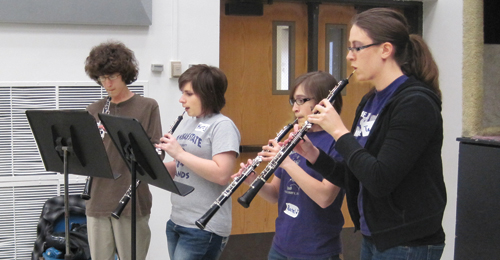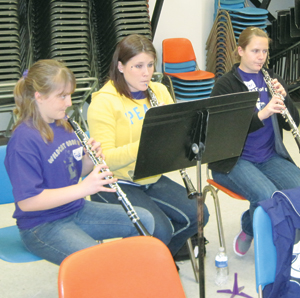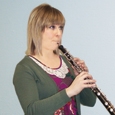
Students often switch to oboe from other instruments. More-over, articulating on the oboe reed without disrupting the airflow is a particularly complicated task to introduce. Even when students have been playing with proper technique on their initial instruments, they tend to develop particular bad habits when they switch to oboe. Once directors and students become aware of these tendencies, focused articulation exercises become more beneficial.
For a good articulation on the oboe, the very tip of the tongue contacts the extreme tip of the reed, with a slight downward motion. For most people, this motion is most similar to whispering the syllable toh. The tongue does not return to the reed to stop the note, so the motion lacks any rebound component. The tongue returns to the reed only to articulate the next note. The tongue should move freely in the mouth, with a slight downward motion that avoids all contact with the upper and lower teeth, the gums, and the roof of the mouth.
This light and precise execution of articulation should be present in every musical style, from the lightest Mozartian run to the heaviest Mahler Adagio. Although the character of these musical styles contrasts greatly, the mechanics of articulation remain identical; the manner in which the tongue contacts the reed is exactly the same throughout all styles. Contacting the reed with greater force for a heavier style simply results in a squeak, not a weightier musical style. This squeak results from disrupted airflow that causes the reed to chirp. Likewise, an attempt at articulating more lightly results in inconsistency and missing the reed and articulation altogether.
Students switching from the flute tend to avoid touching the tongue to the reed. Flutists find the vibrations from the oboe reed an uncomfortable and shocking sensation. To compensate, they typically begin to tongue against their upper teeth, right where the teeth meet the gum, rather than touching the tongue to the reed. Students typically cannot discern whether they are touching their teeth or the reed, but careful observation of the quality and sound of the articulation can offer clues. If a student is tonguing against the teeth instead of the reed, the articulation will lack initial clarity and all resonance of sound is squelched, as a type of vacuum is created, resulting in suction-like sound from the disrupted airflow.
As clarinetists and saxophonists adapt to the oboe, they find the tip of the oboe reed too small a target and they try to impose a greater sensation of stability. They hold the tip of the tongue against the bottom teeth and initiate articulation too far back on the tongue. This phenomenon is known as anchor tonguing, and it is a remarkably common problem with oboists. Saxophonists are inclined to articulate with the syllable kuh, using the back of the tongue at the back of the mouth, to avoid contact with the reed altogether. This kuh sound is similar to the second half of double-tonguing technique but is not appropriate for basic articulation.
It can be difficult to figure out exactly what is going on with the mechanics of articulation, since it is impossible to observe tongue movement while students are playing. When asked direct questions, students will quickly respond that the tip of their tongue is lightly contacting the tip of the reed, when that is not the case. Students respond this way in part because they know that is the correct answer, but also because they do not have the tools to discern kinesthetically what is actually happening.
To a student, it might feel as if the tongue is moving freely, with the tip of the tongue contacting only the tip of the reed, but there are additional factors to consider. For example, the tongue could be moving too far away from the reed or striking the reed too firmly. As articulation becomes more consistent through focused practice, greater variety and nuance to the quality of articulation will emerge. Ultimately, development of specific listening skills offers insight into the mechanics. Airflow and articulation exercises can help to improve kinesthetic awareness that will lead students toward accurate and consistent articulation that does not interfere with airflow or tone quality. Additionally, good quality articulation is contingent on consistent reeds that are stable and responsive, and these exercises will help students to determine how well a reed is functioning.
To begin, isolate what it feels like to tongue on the wind. Take a coffee stirrer (the kind with the tiniest possible opening or the kind with two narrow openings) and blow through it and sustain for as long as it is comfortable, repeating this several times. The extremely narrow opening of the stirrer simulates the aperture of an oboe reed and the fast air used to play oboe. The head and neck should feel very free, similar to the sensation of yawning. When all is done correctly, students will notice that it is easy to sustain for a long time.
Follow the same procedure for 16 counts at a tempo of 50 beats per minute, moving as much air as possible through the stirrer while maintaining the yawning sensation. Before beginning again, form the syllable ooh, which creates considerable space between the upper and lower teeth and causes the lips to move forward, in front of the teeth, similar to an oboe embouchure. Take a comfortably slow breath and place the stirrer between the lips, which should still be in ooh formation. Sustain on the stirrer for another 16 counts. Repeat until this is comfortable and feels natural. Throughout this exercise, it is fine to lightly hold onto the stirrer with one hand. Experiment with how little lip pressure is required to move air through the straw without the air leaking out the sides of the mouth. A fun game for students is to have them let go of the stirrer and see who can launch it across the room with good air flow and very light embouchure pressure.
The next step is to replace the coffee stirrer with the oboe reed alone. Repeat the above procedure with just the reed while still thinking the syllable ooh and producing a pitch of B natural, one half step lower than the crow of the reed. Use the same type of airflow and notice how much resistance the reed provides.
At this point it is time to add the instrument. Use the same exact quality of airflow used with the stirrer and the reed alone. Sustain 16 counts on D5. This note is a good choice for this exercise because it has a significant amount of resistance and is generally quite stable. Over the 16 counts, crescendo slightly at a comfortable mezzo-forte dynamic level.
 Playing the instrument at this point, having followed the above procedures, typically results in a beautiful sound that is resonant, vibrant, and warm with the presence of a wide spectrum of overtones. It should feel like hitting the bulls-eye of the pitch, with resonance so great it is felt under the fingertips. At this point, if the sound is undesirable and lacks resonance, try to identify why that is the case. Common culprits are an oboe reed that is flat in pitch instead of easily crowing a C in octaves, a reed with an opening that is too large, an instrument that is leaking through a pad or crack, or an instrument that is not properly adjusted. Perhaps try a different reed, but do not try to alter the sound through additional embouchure pressure or reduced airflow.
Playing the instrument at this point, having followed the above procedures, typically results in a beautiful sound that is resonant, vibrant, and warm with the presence of a wide spectrum of overtones. It should feel like hitting the bulls-eye of the pitch, with resonance so great it is felt under the fingertips. At this point, if the sound is undesirable and lacks resonance, try to identify why that is the case. Common culprits are an oboe reed that is flat in pitch instead of easily crowing a C in octaves, a reed with an opening that is too large, an instrument that is leaking through a pad or crack, or an instrument that is not properly adjusted. Perhaps try a different reed, but do not try to alter the sound through additional embouchure pressure or reduced airflow.
When the sound is satisfactory, take the coffee stirrer again, sustain for 16 counts at the same slow tempo, and continue to have as little of the stirrer between the lips as possible. Now with the same air flow touch the tip of the tongue to the tip of the stirrer in repeated quarter notes, using a hand to feel the air flow coming out of the straw. Try to hone the tongue motion so it is minimal and has as little contact with the stirrer as possible. There should not be any pulsation or interruption of the air stream. Observe how this contact on the stirrer feels. Try the exercise using the syllable toh for articulation, and repeat this exercise several times, never allowing the air to stop. Experiment with different syllables such as doh, tur, dur, duh, tuh, doo, too, la, loo, and th. Observe which syllables feel the lightest, the heaviest, the most natural, or the most awkward. Have students repeat each several times and try to describe tongue motion. It should be moving very slightly in a downward motion.
As with before, have students move from the coffee stirrer to the reed alone and then the instrument. This time shift the focus to listening to the quality of articulation and continue to refine the tongue motion. Experiment with the different articulation possibilities listed above and observe the subtle differences of each syllable. One good approach is to record them. The feedback from a recording can be helpful for improving objectivity and critical listening. Keep working to verify that the tongue moves freely and minimally, and that only the tip of the tongue touches the tip of the reed.
From here, begin to experiment with different rhythms and tempi. For this exercise, variations should remain as legato as possible to continue to build on the sensation and sound of sustained tonguing on the wind. Build diligent attention to articulation into warmups for students. Once students are on a good track with articulation, it is easy to assume that they will maintain good habits, but the oboe reed is such a significant variable that playing the instrument can feel incredibly different from day to day. This inconsistency allows poor articulation to creep in at any moment.






